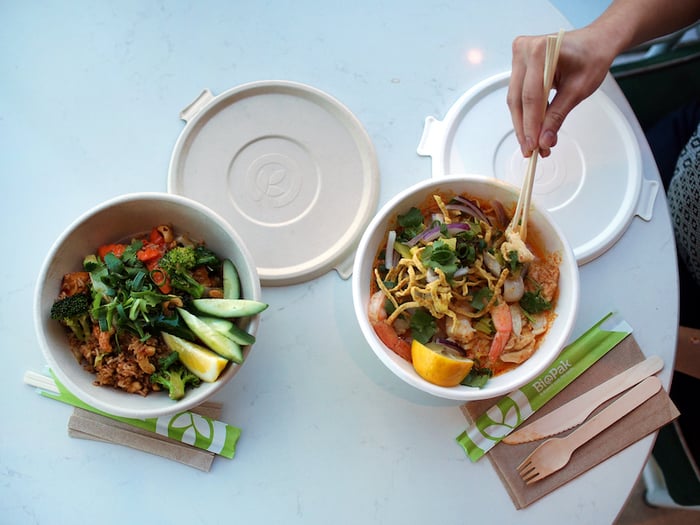
Avoiding Food Service Packaging Mistakes: Key Tips for Success
What's In This Post
- Packaging Mistakes and Solutions
- Mistake #1: Using Too Many Different Packaging Sizes and Options
- Solution: Simplify and Standardise Your Packaging
- Mistake #2: Choosing Low-Quality Packaging Materials
- Solution: Invest in High-Quality Packaging
- Mistake #3: Misalignment Between Container Size and Food Portion
- Solution: Match Packaging Size to Portion Size
- Mistake #4: Neglecting Branding Opportunities in Packaging
- Solution: Use Packaging to Strengthen Your Brand
- Mistake #5: Not Travel-Proofing Packaging for Deliveries
- Solution: Choose Delivery-Optimised Packaging
- Management Mistakes and Solutions
In the food service industry, packaging plays a crucial role in your business's success. It’s more than just a container for your products—it’s a direct representation of your brand and a key factor in customer satisfaction. Yet, many businesses make critical food service packaging mistakes that can lead to inefficiencies, customer complaints, and even lost revenue. In this post, we’ll explore the most common mistakes in food service packaging and provide actionable solutions to help you avoid them.
Packaging Mistakes and Solutions
Mistake #1: Using Too Many Different Packaging Sizes and Options
One common food service packaging mistake is offering too many different container sizes and options. While it might seem logical to have a specific container for each menu item, this approach can quickly turn into a logistical headache. The more packaging options you have, the more storage space you need, and the more complex your ordering process becomes. This increases the risk of ordering the wrong item or running out of a crucial container during peak business hours.
Solution: Simplify and Standardise Your Packaging
To streamline operations, consider narrowing down your packaging options to just 2-3 versatile container sizes that can accommodate most of your menu items. This not only simplifies inventory management but also reduces the space needed for storage. By standardising your food service packaging, you can make it easier for staff to find what they need and reduce the likelihood of running into supply issues.
For example, instead of offering four different cup sizes for cold beverages, stick to two: small and large. Similarly, opt for a standard container size that can handle different portion sizes for your meals. This approach will help you avoid the chaos that comes with managing too many packaging options, making your kitchen more efficient and your business more profitable.
Mistake #2: Choosing Low-Quality Packaging Materials
Another major food service packaging mistake is opting for low-quality materials to save costs. While it might seem like a good idea initially, cheap packaging can lead to significant problems, such as leaks, spills, and even food contamination. These issues not only frustrate customers but can also damage your brand’s reputation.
Solution: Invest in High-Quality Packaging
The best way to avoid this mistake is to invest in durable, reliable packaging materials. Before committing to any product, test it under real-world conditions to ensure it meets the demands of your menu. Whether it’s a hot coffee, a greasy burger, or a cold salad, your packaging should keep the food secure and maintain its quality during transport.
It’s also worth purchasing from established brands and reputable suppliers. While these options might come with a higher upfront cost, they pay off in the long run by minimising customer complaints and enhancing your brand’s image. Quality food service packaging sends a message that you care about your customers’ experience, which can lead to repeat business and positive word-of-mouth.
Mistake #3: Misalignment Between Container Size and Food Portion
Nothing disappoints a customer more than ordering a meal only to receive it in a container that’s either too large or too small. A large container with a small portion can make the food look inadequate, while an overly small container can make a meal seem crammed and unappealing. This misalignment is a frequent food service packaging mistake that can leave customers dissatisfied.
Solution: Match Packaging Size to Portion Size
Ensure that your packaging is appropriately sized for the contents. This means selecting containers that provide enough space for the food without making it look sparse or overcrowded. A well-matched container enhances the customer’s perception of value and ensures a more enjoyable dining experience.
For instance, a generous salad should be served in a container that allows the ingredients to be evenly distributed and easy to eat. Properly sized food service packaging not only improves presentation but also helps reduce food waste by making portions look appetising and well-balanced.
Mistake #4: Neglecting Branding Opportunities in Packaging
In the competitive food service industry, packaging is more than just a means of transportation; it’s a critical branding tool. Many businesses make the mistake of using plain, unbranded packaging, missing out on valuable opportunities to reinforce their brand identity and connect with customers.
Solution: Use Packaging to Strengthen Your Brand
Your packaging is a direct touchpoint with your customers and should reflect your brand’s values and aesthetics. Consider using eco-friendly packaging that aligns with sustainable practices, especially as more consumers prioritise environmental responsibility.
Incorporate your logo, brand colours, or even a catchy slogan on your packaging. Adding a brief message about your commitment to quality or sustainability can also make a strong impression. By turning your packaging into a branding opportunity, you not only enhance the customer experience but also increase brand recognition and loyalty.
Need help designing branded packaging that truly represents your business? We specialise in creating customised, eco-friendly packaging solutions that align with your brand’s identity and values. Get in touch with us to discover how we can help you turn your packaging into a powerful branding tool that leaves a lasting impression on your customers.
Mistake #5: Not Travel-Proofing Packaging for Deliveries
A critical mistake is overlooking the need for packaging that is travel-proof, especially for deliveries. Packaging that fails to secure food properly can lead to spills, leaks, and ultimately, unsatisfied customers who might not return.
Solution: Choose Delivery-Optimised Packaging
When selecting packaging, prioritise those designed for safe travel. Ensure containers have secure lids, are leak-proof, and can withstand the rigours of delivery. Testing your packaging under real delivery conditions can help you identify potential issues before they affect your customers.

Management Mistakes and Solutions
Mistake #6: Inadequate Storage Space
Inadequate storage space is a common challenge, especially for smaller businesses. Balancing the need for kitchen and dining space with sufficient storage for packaging can be difficult.
Solution: Optimise and Extend Storage Options
Consider off-site storage options, such as using the manager’s or owner’s home for excess stock. We deliver many shipments to residential addresses for this purpose, and customers often find courier deliveries more reliable with “authority to leave” (ATL) at these locations. Plus, large boxes of packaging are unlikely to attract porch pirates.
Another way to optimise storage is by reducing the range of packaging products you use. As mentioned earlier, standardising your packaging options simplifies inventory management and makes it easier to keep essential items in stock.
Mistake #7: Missing Order Deadlines or Running Out of Stock
Missing order deadlines or running out of stock is a frequent issue that can disrupt operations. This often happens due to disorganisation or poor processes around ordering and order reminders.
Solution: Implement a Rigorous Ordering Process
Set weekly order reminders for yourself or your staff to ensure orders are placed early in the day and week. This maximises the chances of receiving your order before running out of stock, even if unexpected issues arise.
Additionally, ensure you always hold and order ample stock of your business's most essential packaging items. By doing so, you can avoid disruptions during busy periods or when supply shortages occur, ensuring you’re prepared to continue serving your customers without interruption.
Mistake #8: Staying with Expensive and Unreliable Suppliers
Packaging is as competitive as any other part of the food service industry, making it easy for subpar suppliers to undercut the market. Many business owners don’t have the time to frequently check pricing, and the hassle of switching suppliers often stops change, even after repeated negative experiences.
Solution: Regularly Assess Your Suppliers
The easiest way to test any supplier is by evaluating how often things go wrong and how quickly they resolve issues. This includes dealing with missing or delayed shipments, faulty products, returns, and more. If your supplier consistently mishandles these situations, it’s time to look for better service.
In summary, things go wrong in all business activities, but good suppliers will have your back and keep things moving without unnecessary impacts on your business. If you’re ready to make a switch, consider suppliers that prioritise reliability and customer satisfaction.
Food service packaging is a critical aspect of your business that deserves careful consideration. By avoiding common food service packaging mistakes and implementing the solutions outlined here, you can improve efficiency, enhance customer satisfaction, and strengthen your brand. Remember, the right packaging can make all the difference in how your customers perceive your business and whether they choose to return. Take the time to get it right, and you’ll be well on your way to long-term success.
Final Note: Investing in sustainable food service packaging not only helps the environment but also appeals to eco-conscious consumers. It’s a smart move for both your business and the planet.Ready to elevate your food service packaging? Explore our range of high-quality, sustainable packaging solutions designed to meet the unique needs of your business. Whether you’re looking to reduce waste, improve customer satisfaction, or enhance your brand, we have the perfect packaging options for you. Contact us today to learn more and get started on transforming your packaging strategy.




